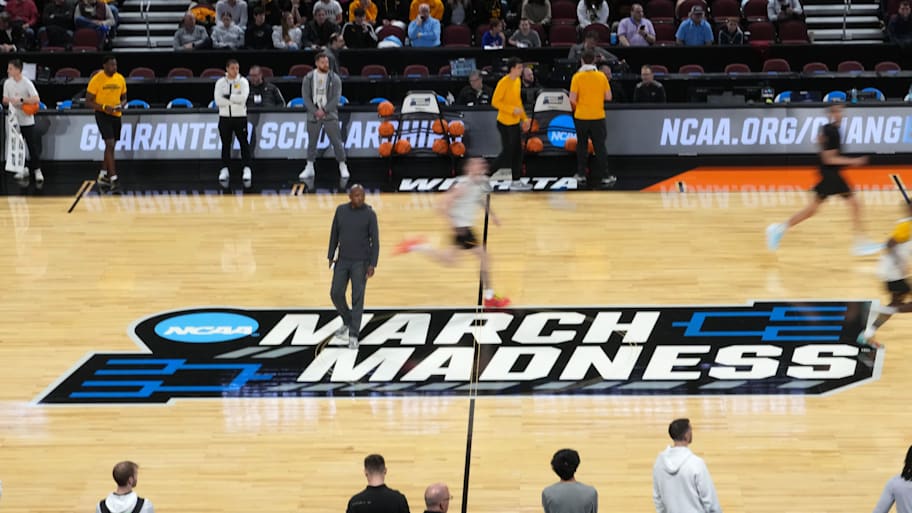
The vandals in charge of college sports are at it again, spray paint cans in hand. They’re standing in front of the Mona Lisa right now, ready to deface their masterpiece a little more.
Wednesday or Thursday, the NCAA Division I men’s basketball committee is expected to decide whether to expand the tournament field from 68 to 72 or 76 (the women’s tournament would grow correspondingly). Most believe the decision will be made to expand. Nobody can find a groundswell of popular support that would justify it.
This potential crime against sporting art is offensive mathematically, geometrically, intellectually and I daresay ethically. It’s a tipping-point scam, unpopular enough to potentially break bonds between the paying public and the product. It’s too many teams, too big an incursion upon the functionality of the bracket, too big an insult to the intelligence of the fans and too flagrant a cash-and-power grab to be countenanced quietly.
If members of the committee go this route, they deserve the blowback they get. So do the conference commissioners prodding them, the twitchy athletic directors scrounging for revenue and the shameless coaches hoping for an easier path to bonuses and job security.
The original sin was expanding from 64 to 65 in 2001, necessitating a play-in game in Dayton, Ohio. The more egregious sin was pumping up to 68 in 2011 and creating the dubious First Four, a quartet of play-in games. This would be another damnable decision, continuing a trend of the College Sports Inc. power brokers taking care of themselves instead of taking care of the sports they oversee.
If there were a group conscience guiding college sports, the following things would be true:
- The Pac-12 would still be alive.
- There would have been no scheming to secure multiple automatic bids for some conferences in the College Football Playoff.
- New rules created via federal mandate might stand a chance of functioning before stakeholders sabotaged them.
- The best single competition in college sports, March Madness, would be protected and maintained in its best form, not crassly manipulated to wring a few more bucks out of NCAA media partners.
But here we are, on the verge of another incursion upon tradition nobody asked for.
There were many previous expansions of the tournament, from eight to 48 and then to the perfect number, 64. That rounded out the bracket, eliminating first-round byes and making uniform the number of games everyone had to win to reach the Final Four and eventually claim a national title. It also was the last bracket to fit perfectly on a photocopied piece of paper, which aided one of the most vital dynamics of the Big Dance’s popularity—the office pool.
Today, the brackets are largely online—but they need to fit uniformly on a laptop or desktop screen, not turned into an unwieldy display. Don’t give casual fans the opportunity to give up on a bracket pool due to complexity, because they just might do it.
A bigger tournament will obviously add to the Tuesday-Wednesday games of the first week of March Madness. People will almost assuredly not watch them in the same kind of numbers they do when the real tournament begins, on Thursday and Friday. The general public hasn’t cared much about them for the first 14 years, and they assuredly won’t now that there is added clutter on those days. The consumers aren’t dumb, and shoving more NIT-level basketball in front of them won’t suddenly become an appetizing prospect.
Beyond messing with geometry and diluting quality, the stated spin about the need for expansion is either faulty logic or plain dishonesty, take your pick. The argument is that Division I has grown by nearly 100 schools since the 1985 expansion, and keeping the field the same size deprives access to a greater number of programs now. Opportunities to participate in the championship are too few, the spinmeisters say.
In truth, almost all of the dozens of added Division I programs are competing in one-bid leagues. Their ascension to D-I isn’t depriving any teams of at-large bids, because they have virtually no shot at getting any of them. In other words, Merrimack, Bellarmine and Lindenwood aren’t taking bids away from underachievers like Nebraska, DePaul and South Carolina; they’re just part of the pool of hundreds of contenders for a single bid from a low-major league.
(Matt Norlander of CBS Sports dove into the math of the rising D-I programs of the last 40 years here. Guess what? They haven’t dented the field in a manner that cost the power cabal anything.)
Expansion is the brainchild of power leagues looking for even more power, even as everything in the game continues to tilt more in their favor. (Scheduling, metrics, exposure, revenue, etc.) As usual in College Sports Inc., the rich are trying to make sure they position themselves to get richer.
The programs that will get in a 72-team or 76-team field will overwhelmingly be the dregs of the top five conferences—the SEC, Big Ten, ACC, Big 12 and Big East. A few bids will go to the next-level leagues like the Mountain West, Atlantic 10 and (dare to dream) Missouri Valley. Almost none will go to the 26–6 regular-season champion of a mid-major league that loses in its conference tournament.
Three years ago, SEC commissioner Greg Sankey floated the idea of an expanded tournament to me. The general public reaction was disdain and disappointment. I’ve heard and seen nothing since then to make me believe there is an increased appetite for a bigger March Madness.
But the leaders have kept maneuvering for it behind the scenes, cajoling their media partners to finally acquiesce and agree to pay more money for more tournament inventory. (Worth noting that ESPN’s response to being asked for more money to broadcast an expanded women’s tournament was, essentially, hell no. They’ll show the games, but they won’t pay extra for them.)
So here we stand, on the cusp of a vote that could further sully the greatest of all postseason tournaments. If it happens, the leaders will dissemble about why expansion was needed and why it’s a good thing. Don’t believe them, and don’t forget it.
They’re not doing it for the fans, or the good of the game. They’re doing it because they can. Those in power never stop trying to acquire more of it.
More College Basketball on Sports Illustrated
This article was originally published on www.si.com as March Madness Is Likely to Expand Because of a Cash-and-Power Grab.







